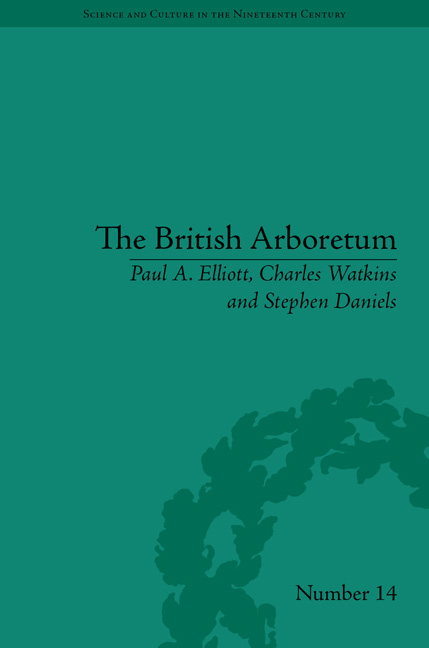Book contents
- Frontmatter
- CONTENTS
- List of Figures
- Preface
- Introduction
- 1 British Tree Cultures in the Nineteenth Century
- 2 Trees and Taxonomy
- 3 British Arboriculture, c. 1800–35
- 4 John Claudius Loudon's Arboretums
- 5 The Botany of the Arboretum Britannicum
- 6 The Derby Arboretum
- 7 Estate Arboretums
- 8 Public Urban Arboretums
- 9 The Transformation of Victorian Public Arboretums
- Conclusion
- Notes
- Works Cited
- Index
1 - British Tree Cultures in the Nineteenth Century
- Frontmatter
- CONTENTS
- List of Figures
- Preface
- Introduction
- 1 British Tree Cultures in the Nineteenth Century
- 2 Trees and Taxonomy
- 3 British Arboriculture, c. 1800–35
- 4 John Claudius Loudon's Arboretums
- 5 The Botany of the Arboretum Britannicum
- 6 The Derby Arboretum
- 7 Estate Arboretums
- 8 Public Urban Arboretums
- 9 The Transformation of Victorian Public Arboretums
- Conclusion
- Notes
- Works Cited
- Index
Summary
Introduction
Late seventeenth-century Britain was one of the least wooded countries in Europe. In broad terms woodland had fallen to less than 5 per cent of the land area compared to the 10 per cent estimated to have existed at the time of Domesday. Moreover, compared to many European counties, the number of trees that could be classed as native to Britain was very low with less than thirty broadleaved species and as few as five evergreens. The geography of tree species resulted from a complicated mixture of environmental conditions and past human activities. Although of small acreage, the woods found in different parts of the country varied considerably: intensively managed oak coppice grown for tannin in Cornwall and Devon; strips of coppiced alder along brooks and rivers in the Midlands; pollarded oaks and ashes and stripped elms found in many hedgerows; while significant areas of native Scots pine were only to be found in Scotland. Partly as a consequence of the small area of woodland, Britain was largely dependent on imported rather than home-produced timber and wood products. In addition, there was very little publicly owned forest apart from some small remnants of Crown forests, such as parts of the Forest of Dean and the New Forest.
- Type
- Chapter
- Information
- The British ArboretumTrees, Science and Culture in the Nineteenth Century, pp. 11 - 36Publisher: Pickering & ChattoFirst published in: 2014

